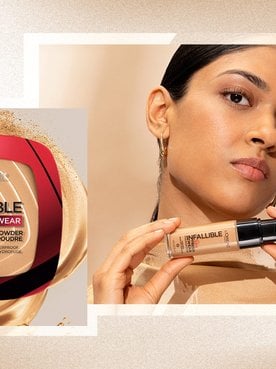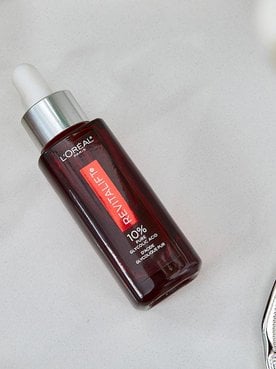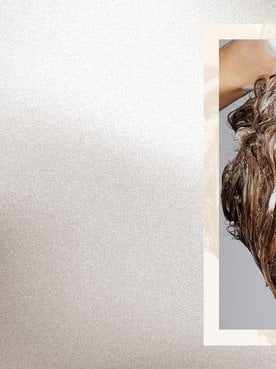When it comes to keeping your skin in tip-top shape, you likely enlist the help of skincare essentials like cleansers, moisturizers, and sunscreens. However, even if you’re religiously using these skincare products, it’s still possible for dead skin cells to build up on your skin’s surface, making it appear dull, rough, and uneven. Knowing how to get rid of dead skin on your face can help keep your skin looking (and, just as importantly, feeling) its best.
Fortunately, you don’t need to adopt a new routine to keep dead skin at bay. Adding an exfoliation step to your existing regimen is, in many cases, more than enough to maintain a soft, smooth complexion. Follow along as we break down everything you should know about dead skin cell buildup, including what causes this skin concern and how to properly exfoliate your face for a more radiant-looking complexion.
What Causes Dead Skin Cell Buildup on Your Face?
Before we explain how to remove dead skin from your face, let’s cover a few basics about what causes this buildup in the first place. Normally, your skin renews itself every 28 days or so—this ongoing process (known as “skin cell turnover”) pushes old skin cells to the surface and makes room for new skin cells to take their place. In fact, research shows that the average person sheds around 50 million dead skin cells per day!
When your skin is healthy, balanced, and properly hydrated, this process is invisible to the naked eye and happens without you even knowing it. However, there are several factors that can slow down your skin’s turnover rate, causing an excess of dead skin cells to stick around on your skin’s surface. This accumulation of dead skin is often the result of dryness, weather conditions, sun exposure, improper skincare, or certain skin conditions. According to the American Academy of Dermatology (AAD), your skin’s cell turnover rate also starts to slow down as you age.
Is Chemical or Physical Exfoliation Better for Dead Skin Cell Buildup?
When learning how to exfoliate your face, there are two methods you can consider: physical (mechanical) exfoliation and chemical exfoliation. Whereas mechanical exfoliants (like scrubs) slough off dead skin cells with gritty particles like seed powders or beads, chemical exfoliants leverage skincare acids (like alpha-hydroxy acids) to help dissolve dead skin cells.
While both of these methods offer exfoliating benefits, chemical exfoliants are often considered the gentler option for people with dry, sensitive, or acne-prone skin. This is because the scrubbing action of physical exfoliants can be too harsh or abrasive for some skin types. If you’re not sure which facial exfoliation method is right for your skin’s unique needs, it’s always best to ask your dermatologist for advice.
How Can I Remove Dead Skin From My Face at Home?
Next, let’s get to the aspect of this topic you’re probably most interested in: learning how to get dead skin off of your face. One of the most effective ways to do this is by adding gentle exfoliation to your skincare routine. When done correctly, exfoliation can buff away dead skin cell buildup and help keep your skin feeling soft and smooth.
Ahead, we’ve outlined four ways to exfoliate skin that you can utilize in order to achieve a luminous, healthy-looking complexion.
Start your routine with a gentle cleanser
Cleansing your skin twice daily helps remove dirt, oil, and other impurities that can clog your pores or cause your complexion to appear dull. In many cases, it can also help reduce dead skin on the face. Before exfoliating, wash your face with a gentle cleanser, such as the L’Oréal Paris RevitaLift Radiant Smoothing Cream Cleanser. Wet your skin, then lightly massage the creamy formula onto your face to gently exfoliate and remove dirt and debris. Once you’re done lathering up, rinse away the cleanser with plenty of lukewarm (not hot) water.
If you’d rather knock out your cleansing and exfoliating steps at the same time, consider reaching for an exfoliating cleanser instead. The L’Oréal Paris RevitaLift Derm Intensives 3.5% Glycolic Acid Cleanser gets our vote—it contains both alpha and beta-hydroxy acids and leaves the skin feeling smooth, hydrated, and refreshed. Plus, it’s gentle enough to use every day—even if you have sensitive skin.
Incorporate chemical exfoliants into your daily routine

Chemical exfoliants can be a great asset for those looking to target dead skin cell buildup on the face. There are plenty of different types of chemical exfoliants, but glycolic acid is one of our favorites. Reap the benefits of this alpha-hydroxy acid (AHA) with an exfoliating serum. The L'Oreal Paris RevitaLift Derm Intensives 10% Pure Glycolic Acid Serum is a great option for anyone looking to refine their skin texture and tone. To use it, lightly pat four to five drops onto clean, dry skin. Once the serum absorbs, you can layer on your favorite (non-exfoliating) nighttime moisturizer to help lock in hydration. If you have sensitive skin, we suggest using this serum two to three nights per week to start. From there, you can build your way up to nightly usage.
Shop the Products
Use a gentle face scrub once per week
Physical exfoliants, such as face scrubs, can help remove dirt, oil, and dead skin cell buildup from your skin’s surface. These options can be useful to use periodically—such as once or twice per week—depending on the formula.
As mentioned earlier, physical exfoliants may not be well-suited for all skin types, so it’s important to read the product label carefully before adding a facial scrub to your routine. We recommend looking for gentle formulas that feature super-fine exfoliating ingredients (which may be less likely to damage your skin’s protective barrier).
Pro tip: For your body exfoliation routine, you can consider opting for a scrub with slightly larger physical exfoliators, since the skin on your body tends to be less sensitive than your face. Try exfoliating with a sugar scrub a few times per week for smoother, softer-feeling skin from the neck down.
Explore exfoliating tools
If you don’t want to use a facial scrub, you can also use certain beauty tools to help remove dead skin on your face. These tools can be a great way to amp up your skincare routine while adding some physical exfoliation into the mix. Here are some of our favorite ways to exfoliate with skincare tools:
- Facial exfoliating brush: Facial exfoliating brushes are handheld tools designed to be used alongside a cleanser to help exfoliate damp skin. There are an array of facial brushes to choose from—including both manual and electric offerings—but we find soft silicone brushes to be the gentlest of the bunch.
- Washcloth: Washcloths are already a staple in many of our shower routines, but they can actually be used to help exfoliate your face, too. Gently rubbing a washcloth over your face in circular motions is all you may need to help remove dead skin on your face.
- Microdermabrasion: If you love the idea of at-home skin treatments, microdermabrasion should be on your radar. Microdermabrasion is a non-invasive treatment that gently exfoliates he top layer of your skin. You can find several DIY microdermabrasion tools that are suitable for at-home use. Keep in mind, however, that performing microdermabrasion at home is generally not as effective as seeing a professional.
Indulge in an at-home peel

If you’re wondering how to get rid of dead skin on your face quickly, a chemical peel may be your best bet. These potent formulas contain a higher concentration of exfoliants than cleansers, toners, and serums and are designed to provide noticeable improvements in skin texture, tone, and overall radiance—even after just one application.
Professional chemical peels can be a great addition to your beauty regimen, but they’re costly (and sometimes require a couple of days of downtime). Instead, consider using an at-home peel, like the L’Oréal Paris Bright Reveal Dark Spot Exfoliant Peel. The professionally-inspired formula contains a trio of acids—alpha, beta, and poly-hydroxy—and provides gentle yet effective exfoliation to help brighten, smooth, and refine the skin.
To use it, wash your face with a mild, non-exfoliating cleanser and pat your skin dry. Then, shake the bottle from side to side and dispense a dollop into the palm of your hand. Spread a thin, even layer of the turquoise-tinted formula onto your face, avoiding your eye and lip area, and let it sit for 15 minutes. Then, rinse with lukewarm water and apply a gentle, non-exfoliating moisturizer. Use it up to four nights per week to help support bright, smooth, even-looking skin.
Shop the Product
Does Moisturizing Help Remove Dead Skin Cells?
In order to remove the accumulation of dead skin cells, you need to incorporate either a physical or chemical exfoliant into your routine. Many people do this with a cleanser, toner, or serum, but there are moisturizers that can help remove dead skin cells, too. If you want to use an exfoliating moisturizer—rather than one simply designed to hydrate your skin—you’ll want to look for a moisturizer that contains alpha-hydroxy acids or beta-hydroxy acids in its formula. Standard moisturizers won’t remove dead skin cells.
With that being said, it’s important to moisturize daily, especially when incorporating exfoliating into your routine. Exfoliation can sometimes leave the skin feeling tight or dry (especially if you already have a drier skin type). Moisturizing consistently can help replenish hydration and keep your skin feeling comfortable. Morning and night, follow your serum application with a gentle, non-greasy moisturizer. If you need a recommendation, we’re big fans of the L’Oréal Paris Collagen Filler Moisture Filler Anti-Aging Moisturizer, which is suitable for all skin types.
In addition to moisturizer, it’s also important to apply sunscreen every day, particularly when using exfoliating acids—certain chemical exfoliants may cause your skin to be more sensitive to the sun. Try the L’Oréal Paris RevitaLift Triple Power Day Lotion SPF 30, which moisturizes your skin while protecting it from the sun’s harmful rays. With this anti-aging sunscreen lotion, you can expect to see firmer, brighter, and refreshed skin in as little as one week. Or, round out your morning routine with the L’Oréal Paris Bright Reveal Broad Spectrum SPF 50 Daily UV Lotion, which is suitable for all skin types and tones. Remember to reapply your sunscreen at least every two hours (and after sweating or swimming) to keep your freshly exfoliated skin shielded from the sun’s harmful rays.
Shop the Products
Next Up: What Causes Clogged Pores and How Do You Get Rid of Them?
Photo courtesy of L’Oréal Paris







